Chapter
Five Part Four
| We now turn to motorcycles and first
a look at Sunbeam in1927. The company’s range of machines
were now fitted with a modified exhaust layout. The
traditional transverse silencer at the front had been moved
to the left hand rear, as on the majority of bikes. A new
design of fork was also introduced. There had been a number
of fork failures in the 1926 T.T. and a much improved Druid
pattern was developed. A clear example of how racing
improved the breed. It is said that these new forks were the
best girder type ever fitted and that they were superior to
some of the much later Tele forks. Wired on tyres were also
fitted to most new Sunbeams. |
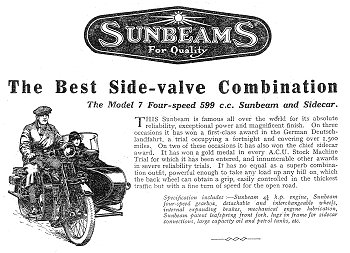 |
During l927 a new Sunbeam model came
out with a 70 x 90mm overhead valve, 347c.c. engine and was
listed at £69.6s.0d.(£69.30).
Other models were as before but the 85 x
l05.5mm, 599c.c. side valve had been reduced by £10 and now
sold for £84, whilst the sidecar outfit now cost £110.5s.0d.
(£110.25), a reduction of 12guineas (£12.60). |
|
From their Graiseley
works A.J.S. also offered a fine and comprehensive range of
machines starting from the Kl2, a 248c.c. sidevalve machine
listed at £39.17s.6d. (£39.88) to the Kl, 799c.c. sidevalve ‘V’
twin sidecar outfit at £95. There were also some very fine
overhead camshaft models on offer.
Howard Davies was
achieving reasonable sales for his HRD machines, and about 40
people were employed at his Fryer Street works. They turned out
some very fine quality sporting machines including what must
have been the ideal of any speedman, the 500c.c. Super 90 T.T.
Replica. It was fitted with a Duplex frame and single port ohv
JAP engine and although reduced from the previous year by around
£8 it still cost a hefty £94.10s.0d.(£94.50). A twin port
600c.c. ohv JAP engine could be fitted for an extra 5 guineas
(£5.25). Equipment on this model included Webb forks fitted with
steering dampers, racing knee grips and a route card holder on
top of the tank.
There were three
other models all prefixed by the "Howard Davies" name. The
75 had a 490c.c. ohv engine with cylinder dimensions of 85.5
x 85mm and cost £63.3s.0d. (£63.15). The 80 included a twin
Port 344c.c. ohv engine and sold at £78.15s.0d. (£78.75).
Some side valve machines were also offered, the 596c.c.
model being listed at £65.2s.0d. (£65.10). HRD also offered
a very attractive “Launch” sidecar with a fabric covered
boat shaped body and a flat deck, with a cowl ventilator and
a small flag staff at the rear.
It appears that at
this time Diamond were in the doldrums, their range being
reduced to just one model, which they continued with detail
improvements until 1928.
Having dealt briefly
with production machines we again turn to the sporting side
and take a quick look at A.J.S. and Sunbeam machines in
trials. |
| The great George Dance won the
Reliance cup for best performance in the Reliance Cup Trial,
where Sunbeam riders also won the Trade and Club team prizes
as well as two silver cups. The premier award and team prize
also went to Sunbeams in the Power Cup Trial, whilst in the
Lancs Grand National and in the North East Rough Riders
Trial the premier award in each went to Sunbeam rider Alec
Jackson. In both events Eddie Flintoff was runner up on a
Sunbeam. |
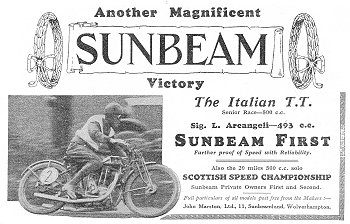 |
|
Among A.J.S. trials
success we can list all of their machines entered in the London
to Edinburgh Trial. They all finished and received Gold medals.
A.J.S. also achieved the best performance of the day in the
Traver's Trophy Trial with a 350c.c. combo, and for the third
year the Premier award. Other successes included best sidecar
performance in the Kickham Trial, two premier cups and six gold
medals in the Colmore Cup Trial. In the London to Lands End no
less than 13 riders of AJs received gold medals and major awards
were won in the International Six Days and Scottish Six Days
Trials.
A.J.S. also had many
successes in speed events as far afield as India, South Africa,
Egypt and the USA. In Europe Jimmy Simpson won the European
Grand Prix in Germany by no less than 30 minutes, and also the
Swiss Grand Prix, Belgian Grand Prix and Austrian Grand Prix. In
the first two he set the fastest lap on his 349c.c. overhead
camshaft machine and at home he won the Brooklands G.P.
It will have been
noticed that Simpson had been riding an overhead cam machine.
Though the 'Big Port' AJS was still a very fast and competitive
motorcycle, it had been beaten in the 1926 Junior T.T. by a
Velocette with an overhead camshaft. Other manufacturers
including Norton were developing engines with this valve layout,
so the Stevens Brothers decided they would need overhead cam
engines for their works machines. As we have seen above, this
was the right thing to do.
The task of designing
the new engine went to Chief Engineer Phil Walker. He positioned
the camshaft across the cylinder head and operated it with a
chain drive that was kept in tension by a Weller device. The oil
pump was mounted on the outside of the aluminium drive chain
cover. The specification included dry sump lubrication and caged
roller big end bearings. Very deep fins were cast into the
cylinder head.
Before the European races the cammy AJ
had appeared in the Isle of Man for the 1927 T.T., where
Jimmy Simpson managed to take third place in the Junior
race. Notwithstanding this and the successes on the
continent the Stevens brothers were none too happy with the
new engine. Whilst it was reliable, it did not have the
speed that was required and so for 1928 they would revert to
pushrod operated overhead valves. The four speed gearbox was
also dropped in favour of a three speed model. |
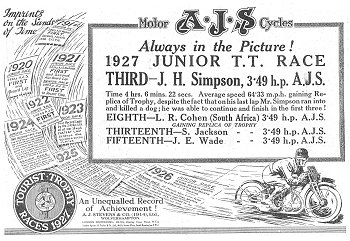 |
9 A.J.S. machines were entered for
the 1927 Junior T.T. along with 3 HRDs and 4 Sunbeams. HRD
machines were being produced and sold in reasonable numbers
and many owners were keen clubmen, who used their mounts in
competitions with little if any support from the works.
Amongst numerous successes there were race wins in Germany,
Japan and Australia, whilst in the London to Exeter Trial
all three HRDs entered received gold medals. |
|
For the 1927 Junior the
three works entries were led by the redoubtable Freddie Dixon
who had been keen to ride the Wolverhampton machines. He
modified his machine in a number of ways including upright
handlebars, a back rest to the saddle, footboards, and
windscreen. Strange fittings for a racing machine, but Dixon was
an individualist. The Sunbeams had been improved and many
enthusiasts thought they could do well with Dodson expected to
put up a good show. The firm favourite was Wal Handley on his
Rex Acme and from the start of the race it looked like a runaway
win, as he led by a good margin. He continued in the lead for
the first six laps and set a new Junior record of 68.18mph. With
only 20 miles to go the Rex cried “enough” and Wal was sidelined
to allow Dixon to go into the lead. He went on to win by
something over 8 minutes from Harold Willis on a Velocette and
the A.J.S. of Jimmy Simpson came in 3rd. Simpson was indeed
lucky to have finished, for whilst travelling at around.
80m.p.h. he struck a stray dog. Jimmy managed to stay aboard the
AJ and continued at unabated speed. As a result of the bump a
chain guard came adrift and got entangled with the chain. Jim
stopped and dropped it off with his bare hands and then
continued to claim his third place, a very good effort. Freddie
Dixon's winning time of 3 hours 55minutes 54 seconds (an average
speed of 67.l9m.p.h.) was a Junior record. |
|
Other Wolverhampton
machine placings were for A.J.S. South African rider L.R. Cohen
who came in 8th, Syd Jackson finished 13th and J.E. Wade
finished in 15th place. Tommy Spann and A.G. Melrose were 17th
and 19th on Sunbeams and the other two HRDs retired. As no
Wolverhampton machines competed in the lightweight classes we
shall now look at the Senior. Although there were 15
Wolverhampton made machines in the race the results would not be
to good for them. Riders included Jimmy Simpson, Charlie Hough
and newcomer to the AJ Team, Aussie Arthur Simcock.
HRD was represented
by Howard Davies, C.P. Wood and Junior winner Freddie Dixon
and on Sunbeams were Graham Walker, Charlie Dodson and Dick
Birch.
|
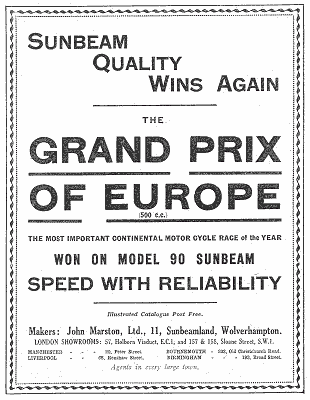 |
| Whilst the Wolverhampton teams were
formidable, Nortons were now in the ascendancy and
with such jockeys as Stanley Woods and Alec Bennett on works
machines the Birmingham marque had to be favourite. From the
start the two star riders dominated the proceedings, though
by lap 5 Woods had a 4 minute advantage over his team mate.
The Irishman then had to retire with mechanical trouble and
Alec Bennett went on to win his third Senior T.T. by just
over 9 minutes from Jimmy Guthrie riding a New Hudson, the
Scotsman’s first T.T. placing. 3rd spot fell to Tom Simister
on a Triumph. Bennett's time had been 3 hours 51 minutes 42
seconds, an average speed of 68.41m.p.h. Woods had set a new
lap record at 70.9m.p.h. |
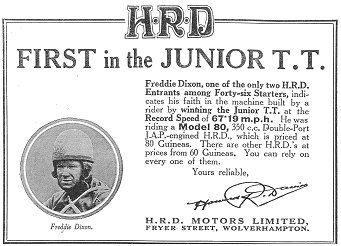 |
Of the Wolverhampton machines Graham
Walker had the best result with 5th place. Dodson on a
Sunbeam finished in 8th place and Dick Birch, also on a
Sunbeam came in 16th. A.J.S. riders George Rowley, Charlie
Hough and R.F. Parkinson came in 9th, 11th, and 15th
respectively. Freddie Dixon took 6th spot on his HRD but
both Howard Davies and Clarrie Wood retired. A pity as this
was his last appearance in an Isle of Man T.T. Davies had
been a great rider and had stamped his name on T.T. history. |
| It was also the last time an official
works HRD would be seen in the Island races. Soon after, the
HRD company went into voluntary liquidation. At this time a
chill wind was beginning to blow through the motorcycle
industry and all manufacturers were feeling it. Of course it
hit the smaller and specialised firms harder. To add to the
economic pressures of the day, the press launched one of its
frequent vendettas against motorcycles in general and in
particular against powerful sporting machines. |
| This hit HRD sales hard and without
enough capital to fall back on there was no alternative but
to end production. A great pity for in its short life the
HRD had blazed its name across the motorcycle world and
brought fame and prestige to its home town of Wolverhampton.
Gaffer Howard Davies was one of the greats of motorcycling
with a fine record of successes as a rider and manufacturer. |
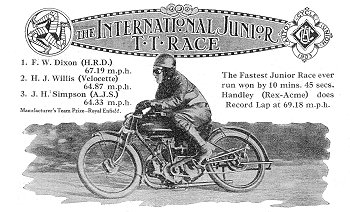 |
| Eventually the name was bought by
Phil Vincent and production moved to Stevenage and the
Vincent HRD was born After the closure of the Fryer Street
works Howard Davies had various jobs in the motor trade,
working for amongst others Alvis, and Star and Swallow
Coachbuilding, but all in all he was very unfairly treated
and died of cancer in 1973. It is ironic that he and Phil
Vincent were not to meet until both attended a Vincent
Owners Club function in 1969.
Having digressed to consider the end of HRD production in
Wolverhampton we shall now look at the report of the 1927
Amateur T.T. The T.T. attracted 75 entries, 21 more than the
previous year. It included twenty three 350c.c. machines, 12
up on 1926. This gave the organisers food for thought
regarding the putting on of a separate race for the Junior
machines. The race day was very wet, even worse than 1926
and there were 6 none starters. The race included 4 A.J.S.
machines, 3 HRDs and no less than 13 Sunbeams.
The race was run in
atrocious conditions and won by Tim Hunt, riding a Norton in
a time of 3 hours 53 minutes 55 seconds, an average speed of
57.66m.p.h. Hunt also made the fastest lap at 60.46m.p.h., a
very good effort in the prevailing conditions. Best placing
by a Wolverhampton machine fell to W.H.T. Meageen riding an
HRD, who took 7th place. Dick Birch came next in on his
Sunbeam and only 25 of the 69 starters completed the course.
The finishers included 6 Sunbeams, 5 HRDs and 2 A.J.S., not
bad at all.
Between the two Isle of
Man races came the Ulster Grand Prix in which Wolverhampton
machinery had so far not done at all well, however things were
about to change.
The 1927 Ulster was
the first occasion when a massed start had been used, and in
the 350c.c. class Charlie Dodson on his Sunbeam dominated
the race, leading from start to finish, to win with a time
of 2 hours 51 minutes 54 seconds. This was at an average
speed of 7l.55m.p.h., the first ever above 70m.p.h.
2nd place fell to Charlie Hough who brought his AJS home, 7
minutes and 3 seconds behind the winner.
The Wolverhampton riders
did not figure in the 500c.c. race. It turned into a three
corner dog fight between Jimmy Shaw on a Norton, Frank Longman
now riding a Rudge and Stanley Woods, also on a Norton. At the
end they finished with less than a minute between them.
|

| Before going on to 1928 we shall look
at yet another Guy Motors vehicle that was ahead of its
time. Over the past few years, six wheel, double decker,
long distance coaches have become a familiar sight on our
motorways. There is nothing new in this, its all been done
before, but in a much smaller way. As we have seen the Guy
six wheel passenger service vehicle was proving popular with
major operators. Customers included Land Liners Ltd. who
proposed to run a regular service between London and
Manchester. Full fronted double deck bodywork was fitted to
the Guy FCX72 chassis which had accommodation for 44
passengers. This could be converted into 21 sleeping berths
for an overnight journey and included toilet and catering
facilities. You could even have bacon and egg on board.
There were no motorways then and the journey time was ten
hours. The fare for a daytime journey was 23 shillings
(£1.15) and an extra seven shillings was charged for a night
journey, making it £l.l0s.0d.{£1.50). Guy were also
developing a new two axle double deck bus chassis, as this
configuration was getting popular with operators. |
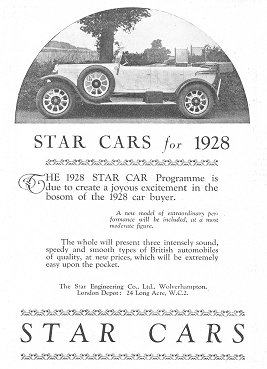 |
We now come to 1928 when there would
be some changes in the Wolverhampton motor firms. Although
Star only produced around 20 cars per week, it must be
remembered that they made most of the vehicles themselves,
unlike many other manufacturers who bought in a large
percentage of components. The Star works in the Frederick
Street and Stewart Street area were very self contained but
cramped. True the body building department had moved to the
new site at Bushbury and other sections were following, but
this was a big operation which would involve the moving of
hundreds of tons of machinery and stores. Before the move
had been completed however, the Lisle family sold out to
Sidney Guy. The sale was by exchange of shares and it is
said that Joseph Lisle received substantial compensation for
not being appointed to the board. Dick Lisle was now
employed as manager of the hardening shop but soon left and
moved away from Wolverhampton. |
|
Before the take over
Star had been building some excellent commercial vehicles
including their very fast “Flyer” coaches, which were purchased
by Scottish Motor Transport amongst others. Users of Star vans
included several London Stores such as Selfridges, the Daily
Mail and the Express & Star. Another notable customer was the
Prince of Wales (Duke of Windsor) who purchased a low loading
chassis fitted with horse box bodywork by Vincents of Reading.
Star also supplied a few 18/50 saloons to Scotland Yard for
Flying Squad duties. It is believed that six specially tuned
engines were produced for this order.
At this time there
had been a few problems with cylinder bore wear and a new
design of engine brought out for the 18/50. It had a quite
unique cylinder block that was made of tough cast iron,
suitable for the stresses involved, whilst the separate
barrels were centrifugally cast in iron of special hard
wearing qualities. This solved much of the problem.
Whilst Guy would
continue Star car production as before, they would of course
have to consider what to do regarding the commercial vehicle
side of the business. They were producing an extensive range
of similar vehicles and so some of the Star models were
dropped, but a new 1.5 tonner with a “Flyer” engine was
introduced .
These were very
difficult times for the motor industry and problems were arising
for Clyno. |
| Whilst production at the
large and modern Bushbury factory continued at a high level,
all was by no means well. Price cutting in the trade
continued to eat into profit margins and they became
dangerously low. During 1928 Morris introduced the 8h.p.
Morris “Minor” to sell at £125. Clyno responded with the
9h.p. “Century” at ten pounds less. Production of 15,000
“Centurys” per year was envisaged, but it proved to be a
disaster and indeed became known around the works as the
“Cemetery”. |
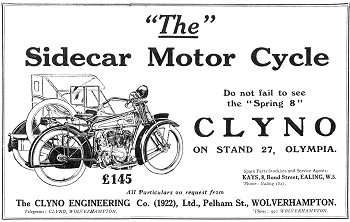 |
|
There can be no doubt it
did put a few nails in the Clyno coffin. Price cutting had been
applied to such an extent that the only place where more could
be done was on the body work. This was carried out and a very
shoddy job resulted. The car proved very hard to sell, in fact
some agents even returned the demonstration models to the works
and in all only about 300 “Centurys” were sold.
Perhaps here we can
continue so as to wind up the Clyno story. For 1929 only two
models were listed, the 9h.p. and the 12h.p. There were price
reductions and the 12h.p. sold for £130, but it just could not
compete with the overhead camshaft 8h.p. Morris “Minor” which
sold for £l25. Although very ambitious, a 22h.p. straight eight
was under development and prototypes were road tested. The end
could no longer be staved off and during March 1929 a receiver
was appointed and production brought to an end. Yet another
famous name of both the motorcycle and car world died. Frank
Smith moved to Star's nearby factory as works manager. |
 |
 |
 |
Return to
Part 3 |
Return to
the beginning |
Proceed to
Part 5 |
|